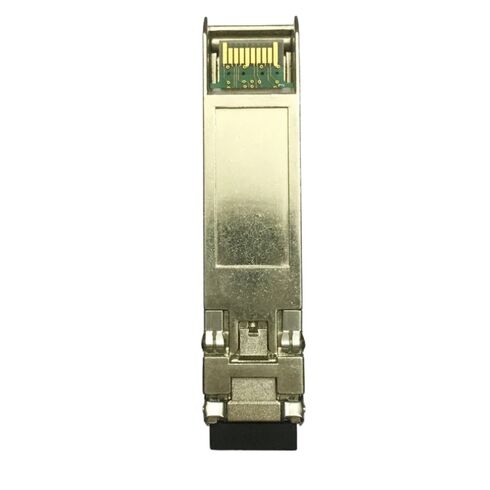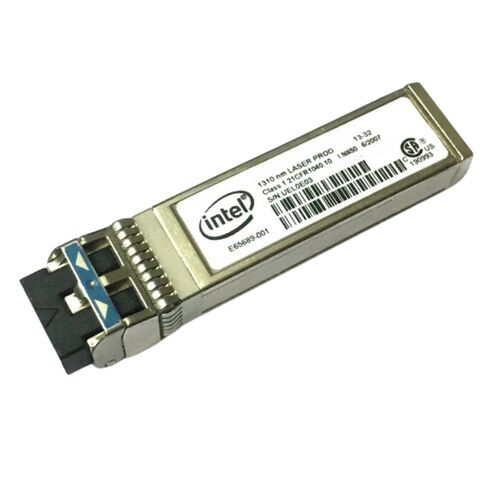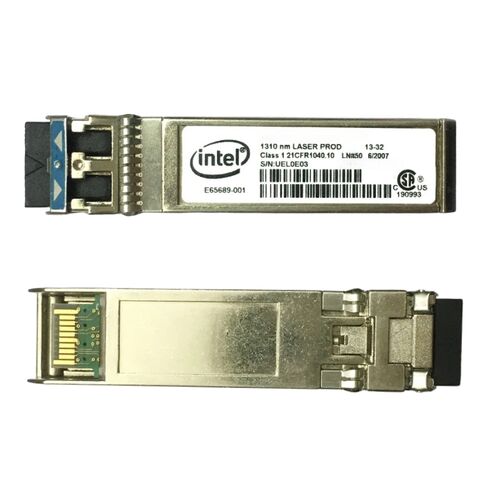E10GSFPSR Intel SFP 10 Gbase-SR Transceiver
- — Free Ground Shipping
- — Min. 6-month Replacement Warranty
- — Genuine/Authentic Products
- — Easy Return and Exchange
- — Different Payment Methods
- — Best Price
- — We Guarantee Price Matching
- — Tax-Exempt Facilities
- — 24/7 Live Chat, Phone Support
- — Visa, MasterCard, Discover, and Amex
- — JCB, Diners Club, UnionPay
- — PayPal, ACH/Bank Transfer (11% Off)
- — Apple Pay, Amazon Pay, Google Pay
- — Buy Now, Pay Later - Affirm, Afterpay
- — GOV/EDU/Institutions PO's Accepted
- — Invoices
- — Deliver Anywhere
- — Express Delivery in the USA and Worldwide
- — Ship to -APO -FPO
- — For USA - Free Ground Shipping
- — Worldwide - from $30
Same product also available in:
| SKU/MPN | Warranty | Price | Condition | You save |
|---|---|---|---|---|
| E10GSFPSR | 1 Year Warranty | $28.00 | Excellent Refurbished | You save: $9.80 (26%) |
| E10GSFPSR | 1 Year Warranty | $43.00 | Factory-Sealed New in Original Box (FSB) | You save: $15.05 (26%) |
Data Rate
The Intel E10GSFPSR SFP 10 Gbase-SR Plug-In Transceiver offers an impressive data rate of 10 Gbps. This high-speed capability makes it an ideal choice for users who require fast and reliable data transmission.
Intel E10GSFPSR Transceiver Specifications
Manufacturer Information
- Brand: Intel
- Part Number: E10GSFPSR
Product Overview
- Category: Networking Equipment
- Type: Optical Transceiver Module
- Model Name: 10 Gigabit Transceiver
Physical Dimensions
- Size: 8 x 6 x 2 Inches
Networking Features
- Connectivity Technology: Wired
- Cabling Standards: 1000Base-SX, 10GBase-SR
- Data Link Protocols: Gigabit Ethernet, 10 Gigabit Ethernet
Expansion and Connectivity Options
- Interface: 1 x Ethernet Network Port (10GBase-SR)
- Compatible Slots: 1 x SFP+ Slot
Key Benefits
- High-speed data transmission with 10 Gigabit Ethernet support.
- Reliable wired connectivity for stable network performance.
- Compact size for easy integration into existing setups.
Applications
- Ideal for network upgrades requiring faster speeds.
- Suitable for use in data centers and enterprise networks.
- Enhances network infrastructure with high-performance transceivers.
Additional Information
- Ensure compatibility with your current network hardware before purchase.
- Check the manufacturer's guidelines for installation and maintenance tips.
Benefits of 10 Gbps Data Rate
The 10 Gbps data rate provided by the Intel E10GSFPSR SFP transceiver brings several benefits to users:
1. Increased Bandwidth
With a data rate of 10 Gbps, users can experience significantly increased bandwidth compared to lower-speed transceivers. This allows for faster and more efficient data transfer, enabling high-performance applications and reducing network congestion.
2. Improved Efficiency
The high data rate of 10 Gbps enables users to handle large amounts of data more efficiently. Whether it's transferring large files, streaming high-definition video, or running demanding applications, the Intel E10GSFPSR SFP transceiver ensures smooth and uninterrupted performance.
3. Future-Proofing
As technology continues to advance, the demand for higher data rates will only increase. By investing in a transceiver with a 10 Gbps data rate, users can future-proof their network infrastructure and ensure compatibility with upcoming technologies and applications.
The Importance of 10 Gbps Data Rate
The importance of the 10 Gbps data rate offered by the Intel E10GSFPSR SFP transceiver cannot be overstated. In today's digital age, where data is constantly being generated and consumed at an unprecedented rate, having a high-speed data transmission capability is essential for businesses and individuals alike.
Applications Requiring High Data Rates
Several applications greatly benefit from the 10 Gbps data rate provided by the Intel E10GSFPSR SFP transceiver:
1. Data Centers
Data centers handle massive amounts of data, often requiring lightning-fast data transfer speeds. The 10 Gbps data rate ensures that data centers can handle the increasing demands of cloud computing, virtualization, and big data analytics.
2. High-Performance Computing
High-performance computing environments, such as scientific research facilities and financial institutions, rely on fast and efficient data processing. The 10 Gbps data rate enables these environments to perform complex computations and simulations without bottlenecks.
3. Media and Entertainment
The media and entertainment industry heavily relies on high-speed data transmission for tasks like video editing, streaming, and content distribution. With a 10 Gbps data rate, media professionals can transfer large video files quickly and efficiently.
Connector Type
The Intel E10GSFPSR SFP transceiver features an LC connector type. This connector type offers numerous benefits and is widely used in the networking industry.
Benefits of LC Connector Type
The LC connector type provides several advantages to users:
1. Small Form Factor
LC connectors have a small form factor, making them ideal for high-density applications. They take up less space than other connector types, allowing for more connectors to be installed in limited rack space.
2. Easy Installation and Maintenance
LC connectors are easy to install and maintain due to their simple design. They feature a push-pull mechanism that allows for quick and secure connections, reducing installation time and minimizing the risk of connection errors.
3. Low Insertion Loss
LC connectors have low insertion loss, which refers to the amount of signal loss that occurs when light passes through the connector. This low insertion loss ensures minimal signal degradation, resulting in improved overall performance and reliability.
The Importance of LC Connector Type
The LC connector type plays a crucial role in networking environments, offering the following advantages:
1. Flexibility
The small form factor of LC connectors allows for greater flexibility in network design and installation. They can be used in a variety of network devices, including switches, routers, and servers, enabling seamless connectivity between different components.
2. Interoperability
LC connectors are widely adopted in the networking industry, ensuring interoperability between various manufacturers' equipment. This compatibility allows users to mix and match components from different vendors without compatibility issues.
3. Higher Port Density
With their small form factor, LC connectors enable higher port density in networking equipment. This is particularly beneficial for data centers and enterprise networks that require a large number of connections in a limited space.
Wavelength
The Intel E10GSFPSR SFP transceiver operates at a wavelength of 850 nm. This specific wavelength provides numerous benefits and is commonly used in fiber optic communication.
Benefits of 850 nm Wavelength
The use of the 850 nm wavelength offers several advantages to users:
1. Compatibility with Multi-mode Fiber
The 850 nm wavelength is well-suited for multi-mode fiber optic cables. Multi-mode fiber is commonly used for short-distance connections within buildings or campuses. By operating at 850 nm, the Intel E10GSFPSR SFP transceiver ensures compatibility with these widely deployed multi-mode fiber networks.
2. Cost-Effectiveness
Multi-mode fiber optic cables are generally more cost-effective compared to single-mode fiber cables. The use of the 850 nm wavelength allows users to take advantage of the cost savings associated with multi-mode fiber infrastructure.
3. High Data Transmission Rates
The 850 nm wavelength supports high-speed data transmission rates, making it suitable for applications that require fast and reliable communication. Whether it's transmitting data in a data center or connecting network switches, the 850 nm wavelength ensures efficient and high-quality signal transmission.
The Importance of 850 nm Wavelength
The choice of the 850 nm wavelength in the Intel E10GSFPSR SFP transceiver holds significant importance for users in various networking scenarios:
1. Short-Distance Communication
The 850 nm wavelength is ideal for short-distance communication within buildings or campuses. It allows for reliable data transmission over multi-mode fiber optic cables, ensuring seamless connectivity between network devices.
2. Scalability
With the 850 nm wavelength, users can easily scale their network infrastructure as their needs grow. The compatibility with multi-mode fiber provides flexibility and cost-effectiveness when expanding or upgrading network connections.
3. Versatility
The 850 nm wavelength offers versatility by supporting a wide range of applications. Whether it's connecting servers, switches, or storage devices, the Intel E10GSFPSR SFP transceiver ensures compatibility and reliable performance across different networking environments.
Distance Supported
The Intel E10GSFPSR SFP transceiver supports a maximum distance of 300 meters. This impressive distance capability brings several benefits to users who require long-range connectivity.
Benefits of 300-Meter Distance Support
The ability to support distances of up to 300 meters offers several advantages to users:
1. Extended Reach
With a distance support of 300 meters, the Intel E10GSFPSR SFP transceiver allows users to establish connections over a longer distance. This is particularly beneficial in large-scale networking environments, such as data centers or enterprise networks spanning multiple floors or buildings.
2. Flexibility in Network Design
The 300-meter distance support provides flexibility in network design and layout. Users can establish connections between devices that are physically distant, enabling efficient communication and resource sharing across the network.
3. Future-Proofing
By supporting a distance of up to 300 meters, the Intel E10GSFPSR SFP transceiver offers future-proofing capabilities. Users can confidently deploy this transceiver knowing that it can handle long-distance connections and accommodate potential network expansions or changes in the future.
The Importance of 300-Meter Distance Support
The 300-meter distance support provided by the Intel E10GSFPSR SFP transceiver holds significant importance for users requiring long-range connectivity:
1. Inter-Building Connectivity
In scenarios where network devices are located in different buildings, the 300-meter distance support ensures seamless connectivity. Users can establish reliable connections between buildings, enabling efficient data transfer and resource sharing.
2. Large-Scale Deployments
Large-scale networking environments, such as data centers or enterprise networks, often span vast areas. The 300-meter distance support allows for optimal connectivity within these environments, ensuring efficient and reliable communication between network devices.
3. Network Expansion
The ability to support distances of up to 300 meters enables users to expand their network infrastructure without limitations. Whether it's adding new devices or extending network coverage, the Intel E10GSFPSR SFP transceiver provides the necessary reach to accommodate growth and changes in network requirements.
Compatibility
The Intel E10GSFPSR SFP transceiver is compatible with multi-mode fiber. This compatibility opens up a wide range of networking possibilities and ensures seamless integration into existing infrastructure.
Benefits of Multi-mode Fiber Compatibility
The compatibility with multi-mode fiber brings several benefits to users:
1. Cost-Effectiveness
Multi-mode fiber optic cables are generally more cost-effective compared to single-mode fiber cables. The compatibility with multi-mode fiber allows users to take advantage of the cost savings associated with this widely used and readily available fiber type.
2. Versatility
Multi-mode fiber is suitable for a variety of applications, ranging from short-distance communication within buildings to high-speed data transmission in data centers. The compatibility with multi-mode fiber ensures versatility and enables users to deploy the Intel E10GSFPSR SFP transceiver in different networking scenarios.
3. Easy Integration
With its compatibility with multi-mode fiber, the Intel E10GSFPSR SFP transceiver can seamlessly integrate into existing network infrastructure. Users can leverage their current multi-mode fiber deployments without the need for extensive modifications or upgrades.
The Importance of Multi-mode Fiber Compatibility
The compatibility with multi-mode fiber is crucial for users in various networking environments:
1. Existing Infrastructure
Many organizations already have multi-mode fiber deployed in their network infrastructure. The compatibility of the Intel E10GSFPSR SFP transceiver allows them to leverage their existing investments, avoiding the need for costly re-cabling or infrastructure changes.
2. Flexibility in Network Design
Multi-mode fiber offers flexibility in network design due to its ability to support different types of connections and distances. The compatibility with multi-mode fiber enables users to design and deploy networks that meet their specific requirements without limitations imposed by the transceiver's compatibility.
3. Scalability
As network requirements evolve, the compatibility with multi-mode fiber ensures scalability. Users can easily expand their network infrastructure or upgrade their equipment while maintaining compatibility with existing multi-mode fiber installations.
Form Factor
The Intel E10GSFPSR SFP transceiver features a form factor known as SFP+ (Small Form-Factor Pluggable Plus). This form factor offers several benefits and is widely adopted in the networking industry.
Benefits of SFP+ Form Factor
The SFP+ form factor provides several advantages to users:
1. High Port Density
SFP+ modules have a small form factor, allowing for high port density in networking equipment. This is particularly beneficial for data centers and enterprise networks that require a large number of connections in a limited space.
2. Hot-Pluggable Design
SFP+ modules are hot-pluggable, meaning they can be inserted or removed from a device without powering off the system. This hot-pluggable design facilitates easy installation, maintenance, and upgrades, minimizing downtime and reducing the risk of system disruptions.
3. Interoperability
The SFP+ form factor ensures interoperability between different networking devices. It is widely adopted by various manufacturers, enabling users to mix and match SFP+ modules from different vendors without compatibility issues.
The Importance of SFP+ Form Factor
The SFP+ form factor plays a crucial role in networking environments, offering the following advantages:
1. Flexibility in Network Design
The small form factor of SFP+ modules allows for greater flexibility in network design and installation. They can be used in a wide range of network devices, including switches, routers, and servers, enabling seamless connectivity between different components.
2. Scalability
The SFP+ form factor ensures scalability by allowing users to easily add or replace modules as network requirements change. This flexibility enables network expansions or upgrades without the need for significant infrastructure changes.
3. Cost-Efficiency
SFP+ modules are cost-effective compared to other form factors. Their small size and high port density contribute to overall cost savings in terms of equipment, cabling, and power consumption.
Protocol Supported
The Intel E10GSFPSR SFP transceiver supports the 10 Gigabit Ethernet protocol, which is widely used for high-speed networking applications. This protocol support brings several benefits and ensures compatibility with modern networks.
Benefits of 10 Gigabit Ethernet Protocol Support
The support for the 10 Gigabit Ethernet protocol brings numerous advantages to users:
1. High-Speed Data Transfer
The 10 Gigabit Ethernet protocol enables fast and efficient data transfer at speeds of up to 10 Gbps. This high-speed capability is crucial for demanding applications, such as data centers, high-performance computing, and video streaming.
2. Compatibility with Modern Networks
The 10 Gigabit Ethernet protocol has become the standard for modern networks due to its high performance and scalability. The support for this protocol ensures compatibility with a wide range of networking equipment and enables seamless integration into existing infrastructure.
3. Future-Proofing
As technology advances, the demand for higher network speeds will only increase. By supporting the 10 Gigabit Ethernet protocol, the Intel E10GSFPSR SFP transceiver offers future-proofing capabilities, ensuring compatibility with upcoming technologies and applications.
The Importance of 10 Gigabit Ethernet Protocol Support
The support for the 10 Gigabit Ethernet protocol in the Intel E10GSFPSR SFP transceiver holds significant importance for users in various networking scenarios:
1. Data Centers
Data centers require high-speed and reliable connectivity to handle massive amounts of data. The support for the 10 Gigabit Ethernet protocol ensures that the Intel E10GSFPSR SFP transceiver can meet the demanding requirements of data center environments.
2. High-Performance Computing
High-performance computing relies on fast and efficient data transfer for complex calculations and simulations. The support for the 10 Gigabit Ethernet protocol enables seamless integration of the Intel E10GSFPSR SFP transceiver into high-performance computing environments.
3. Enterprise Networks
Enterprise networks, particularly those with heavy data traffic, can benefit from the high-speed capabilities of the 10 Gigabit Ethernet protocol. The Intel E10GSFPSR SFP transceiver ensures fast and reliable connectivity, enhancing productivity and enabling efficient collaboration across the network.











